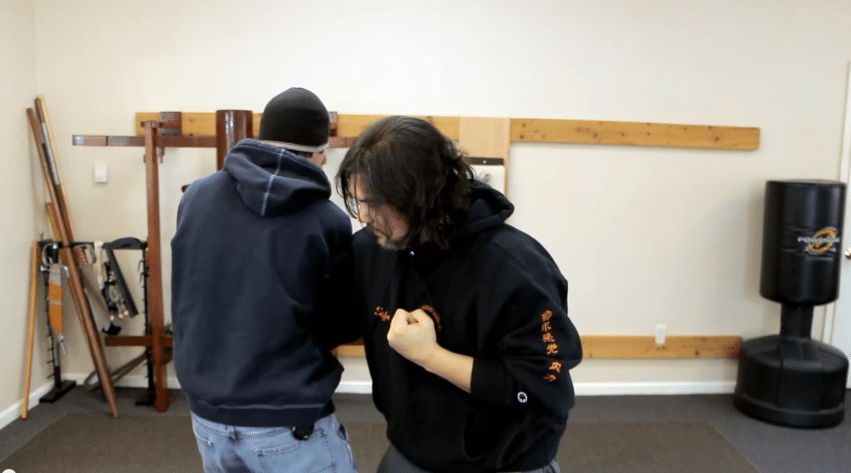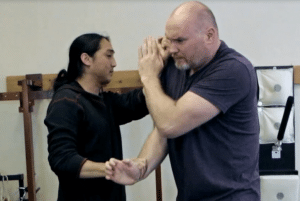In this blog post, we are going to discuss some of the different ranges in Chi Sao. We are also going to answer some common questions that get asked.
In this Kung Fu lesson, online Sifu Phu Ngo talks about fighting at 2 different ranges within Chi Sao.
There are advantages and disadvantages to both ranges. Ideally, you would want to be able to play in both ranges.
When your opponent is further off you have more power to push, however, you have less control of your opponent.
When your opponent is closer to you, you can control your opponent better, however, you lose some of your power.
There is a give and take aka balance in everything. Some folks mistake Wing Chun Chi Sao’s training for fighting. Chi Sao is not fighting, it is a way to bridge the gap between training sensitivity and sparring.
Both Chi Sao and sparring can help you prepare for a competitive match or fight. One of the most common reasons a person loses a fight is that they have an adrenaline dump.
Simply put, they lose their game. What is left is a person who is confused, disoriented, and no longer has the desire to keep fighting. Essentially they end up losing themselves. We strive to be ‘cool, calm and collected under pressure. Training in Chi Sao helps to achieve this.
Related Chi Sao Questions
What is Chi Sao?
Chi Sao is a sensitivity game that teaches the practitioner how to anticipate the actions of their partner by sticking to their opponent’s arms. The practice starts with 1 person holding a Tan Sao and Bong Sao while their training partner is holding 2 fooks on top of their partner. The person with the tan and bong would be considered to be on the inside, while the person holding 2 fooks would be considered to be on the outside. The objective is to land strikes or trap their opponent.

How Do I Learn Chi Sao?
It took me 5 years of learning Wing Chun before I started learning Chi Sao. This is because Sifu Phu wanted to make sure that I understood the basics before moving to the more intermediate level of Wing Chun. The progression looks like this. You first learn Sil Lum Tao And Chum Kiu.
The first 2 forms in the martial art system. In our Ngo Dac Na Wing Chun, we learn to play a game we affectionately call the game of hands. This game teaches you to use your basic deflections and entry moves. The game also introduces you to the concept of flowing.
After some time passes, (it’s different for everyone) you will be ready to learn and train don chi sao. This exercise prepares you to learn Chi Sao. Finally, after some patience, lumps, and bruises you are ready to learn arguably the most important training you will ever get in Wing Chun, Sticky Hands AKA Chi Sao.
How Can I Practice Chi Sao Alone?
I added this question in because it gets asked frequently. While there are hundreds of different training tools a lot of different things you can do to train alone. Chi Sao unfortunately isn’t one of them. There are training devices like a chi sao spring arm which are connected to a chi sao trainer. So you can train some aspects alone. But the most important lessons you learn from Chi Sao come from practicing with a partner.
Chi Sao Wrap Up
Chi Sao not only trains your sensitivity skill it is also a good way to gauge how well you are doing against others in a safe environment. While Chi Sao isn’t fighting, it’s the closest thing to a fight you will get. It’s sort of like sparring. It’s not fighting, but it can be close depending on who you are training with.


Dear Sifu Phu
I had my eyes opened to the beauty of energy through the Leung Ting system of Wing Chun and acquired a Mook Yan Jong because of it.My question or double question if not too boring for you to take the time to answer for me please is….1.because I am still trying to understand the fascinating Siu Nim Tau,why are the 3 Fook Sau’s perfomed very slowly apart from eliminating shoulder tension?? And can Siu Nim Tau be practised solely on my Mook.Do you sell dvd’s?(sorry 3 questions) Because I am in a dire situation financially and can no longer afford to go to the Wing Chun lessons I so used to adore,i feel the purchase of 1 of your dvd’s would enhance and clarify infinitely my understanding of what I’m meant to be achieving through Siu Nim Tau.I appreciate how busy your life must be and there is no rush for a reply from you….a reply none the less would be as appreciated for me as the air I breathe and the sunrises and sunsets I’m privileged to witness.Thank you sincerely. Richard
Hi Richard, you will find lots of lessons on Wing Chun inside our Training Courses
Hey Richard. To answer your question, 1 there are basically 3 methods of playing your form. You should not only do your fook sau slowly, but your whole entire form slowly. This helps build control for every inch of movement you make and not just letting momentum throw it in place. You develop more control this way. 2, you can practice your form onto the jong and much much more. The form is a teaching method to develop muscle and tendon control from the arms to the wrist. Once you learn that, you can take any movement in your form and put them in any order when practicing hitting on the jong. 3, we don’t have dvd’s right now but we do have the web site that is constantly growing and improving (thanks to you guys). We have talked about making dvd’s for people who are interested in just that. My recommendation is join the site. It has over 300 hours and growing every week and we are always improving on it. So when your ready, come join our family.
Sifu Phu
Thank you so much for your reply……very helpful and informative.I’ve sent emails and messages to instructors even in my own county and further afield in the UK asking similar things and never even had a reply.I will avidly keep my deep interest in your newly found website which shows me how much there is to learn and how far there is to go,and even then the suface has only been scratched or the tip of the iceberg has only just become visible on top of many more icebergs.As Mr Spock used to say ‘Fascinating’
Richard
Thanks. I learn day by day and enjoy practicing all that you’ve shared.
Vinaka
Koli from Fiji
Oh, you’re welcome!!!!